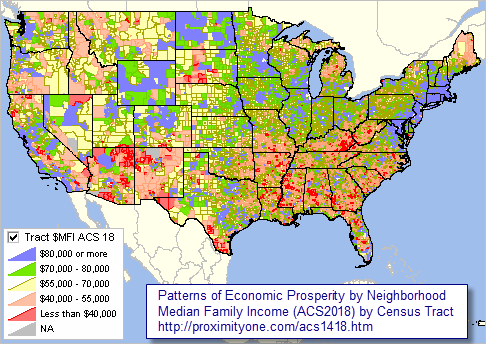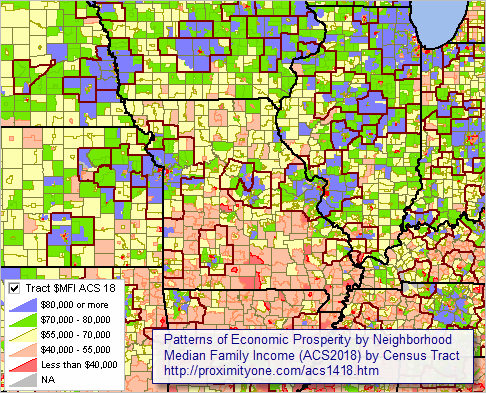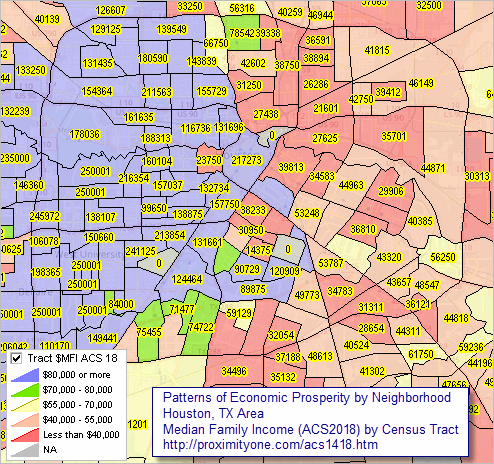

|
|
-- ACS 2018 5-year estimates -- annually updated demographic-economic data to the block group level Essential data to assess where we are, how things have changed and how things might change in the future down to the sub-neighborhood level. The American Community Survey (ACS) is a nationwide survey designed to provide annually updated demographic-economic data for national and sub-national geography. ACS provides a wide range of important data about people and housing for every community across the nation. The results are used by everyone from planners to retailers to homebuilders and issue stakeholders like you. ACS is a primary source of local data for most of the 40 topics it covers, such as income, education, occupation, language and housing. ProximityOne uses ACS data to develop current estimates on these topics and 5-year projections. This section is focused on ACS 2018 data access, integration and use. A similar set of data are produced/released annually. It is updated periodically. Register to receive updates. See related ACS 2017 5-year section. Using the ACS 2018 5-year Estimates ... goto top patterns of economic prosperity by neighborhood; census tract The following graphic shows patterns of ACS 2018 5-year estimates of median family income by census tract. Colors assigned to income intervals are shown in the inset legend. This view illustrates use of just one subject matter item for one type of geography. Click graphic for larger view. Expand browser window to full screen for best quality view. Larger view illustrates how CBSAs/MSAs can be shown contextually.  .. view created with ProximityOne CV XE GIS software and related GIS project. The above map provides many insights. Patterns and insights are immediately consumable in a collaborative setting or published document. Zoom-in View, Adding County Boundaries ... goto top patterns of economic prosperity by neighborhood; census tract Similar to the above view, the following graphic shows patterns of ACS 2018 5-year estimates of median family income by census tract with zoom-in to midwest. Colors assigned to income intervals are shown in the inset legend. Click graphic for larger view. Expand browser window to full screen for best quality view. Larger view illustrates how CBSAs/MSAs can be shown contextually.  .. view created with ProximityOne CV XE GIS software and related GIS project. Add your own data. Use different subject matter for geospatial analysis. Mathematically combine ACS 2018 subject matter items. Choose your own labels. Set display criteria to meet your needs. Further Drill-down; Houston, TX inner beltway area ... goto top patterns of economic prosperity by neighborhood; census tract Similar to the above view, the following graphic shows patterns of ACS 2018 5-year estimates of median family income ($MFI) by census tract with zoom-in to Houston, TX inner beltway area. Colors assigned to income intervals are shown in the inset legend. Tracts are labeled with $MFI. Click graphic for larger view. Expand browser window to full screen for best quality view. Larger view shows tracts labeled with $MFI (yellow label) and the census tract code (white label). Some tracts show the top coded value of $250,001, indicating the value is $250,000 or more. In this view, all tracts are within Harris County, TX (48201) so the 6 character tract code uniquely identifies the tract.  .. view created with ProximityOne CV XE GIS software and related GIS project. Tip of the Iceberg; Illustrating More Detailed Data in Profile/Tabular Form ... goto top Toward the center of the larger map shown for the Houston drill-down, above, note the two adjacent higher and lower $MFI tracts (100000 and 410100, or sometimes shown as 1000.00 and 4191.00). The $MFI values are item E086 shown in the economic profiles for these tracts accessed by clicking the links below. Using these organized profiles, it is easy to view related attributes of these tracts and how they are similar or different. Even with the approximate 522 subject matter items for the profiles, this set of subject matter items remains the "tip of the iceberg". More detailed data contained in tables (see table shells) further down in this section. Tract 48-201-100000 General Demographics .. Social Characteristics .. Economic Characteristics .. Housing Characteristics Tract 48-201-410100 General Demographics .. Social Characteristics .. Economic Characteristics .. Housing Characteristics ACS 2018 Data Release Dates ... goto top Statistical Release Dates shows these dates in context of other release dates. • 2018 ACS 1-year estimates .. September 26, 2019 .. estimates for areas 65,000 population and over • 2018 ACS 1-year PUMS data .. November 14, 2019 .. microdata data for custom estimates and individual modeling • 2018 ACS 5-year estimates .. this section .. December 19, 2019 .. estimates for all areas down to block group level • 2018 ACS 5-year PUMS data .. January 30, 2020 .. microdata data for custom estimates and individual modeling • 2018 ACS 1-year supplemental estimates .. February 6, 2020 .. selected 1 year estimates for areas 20,000 population and over Reference .. go top • ACS 2018 Questionnaire • Summary File Technical Documentation • ACS 2018 Tables Shells • ACS 2018 5-year Sequence Table Lookup • ACS 2018 5-Year Appendices • ACS 2018 5-Year Appendices BG -- tables available by BG Using ACS Data; ACS 1-Year versus ACS 5-Year Data .. top While ACS 1-year estimates are suitable for time-series analyses, the ACS 5-year estimates are not the same as annual demographic-economic estimates and may not be suitable for annual time series analyses. Advantages of using the 5-year estimates • the data are available for all census tracts and ZIP code areas. • the data are available for all cities/places, counties and school districts irrespective of size. Disadvantages of using the 5-year estimates • the data are older than the 1-year estimates. • the data are for a 5-year period rather than one year. • additional cautions in comparing estimates over time (see below). Advantages of using the 1-year estimates • the data are more recent than the 5-year estimates. • the data are generally more accurate than the 5-year estimates. Disadvantages of using the 5-year estimates • the data are not available for census tracts and ZIP code areas. • the data are available for only areas of 65,000 population and over. • the margin of error (MOE) of the estimate is normally larger that for the 5-year estimates. Additional cautions in comparing estimates over time • ACS 2012 5 year estimates are based on survey respondent data for the years 2008 through 2012. • ACS 2013 5 year estimates are based on survey respondent data for the years 2009 through 2013. • ACS 2014 5 year estimates are based on survey respondent data for the years 2010 through 2014. • ACS 2015 5 year estimates are based on survey respondent data for the years 2011 through 2015. • ACS 2016 5 year estimates are based on survey respondent data for the years 2012 through 2016. • ACS 2017 5 year estimates are based on survey respondent data for the years 2013 through 2017. • ACS 2018 5 year estimates are based on survey respondent data for the years 2014 through 2018. • The ACS 2012 5 year data & ACS 2013 5 year data are based on the same respondent data for the four years 2009 through 2012. • The ACS 2013 5 year estimates drop 2008 respondents and add 2013 respondents. • The ACS 2014 5 year estimates drop 2009 respondents and add 2014 respondents. • The ACS 2015 5 year estimates drop 2010 respondents and add 2015 respondents. • The ACS 2016 5 year estimates drop 2011 respondents and add 2016 respondents. • The ACS 2017 5 year estimates drop 2012 respondents and add 2017 respondents. • The ACS 2018 5 year estimates drop 2013 respondents and add 2018 respondents. • While 5-year estimates are independently developed annually, they include demographic-economic characteristics for some of the same respondents. Other considerations • Are the needed subject matter available from Census 2010? - ACS more detailed demographic-economic data (like income) may not be a plus. • Census 2010 provides more accurate data than ACS estimates. • Often there are more detailed age (and other) breakouts for subject matter in Census 2010 compared to ACS. • The most recent ACS-sourced small area data are from ACS 2017 (December 2018) 5-year estimates; - ACS 2017 5-year estimates are centric to 2015. Areas Published ... goto top ... this general description will be updated with specific ACS 2018 geography soon. ... availability of summary statistic data by type of geography ... link in left column provide access to related interactive tables for specific geographic level.
Notes ... 1 County equivalents include Alaska boroughs, municipalities, city and boroughs, and census areas; Louisiana parishes; Puerto Rico municipios; independent cities in Maryland, Missouri, Nevada, and Virginia. 2 For 1-year estimates, qualifying Minor Civil Divisions in 20 states only. For 5-year estimates, all county subdivisions. 3 1-year estimates are not produced for this geographic level, regardless of population size. 4 All metropolitan statistical areas receive ACS 1-year estimates. A population minimum of 50,000 is applied instead of the standard 65,000. 5 Legislative session year 2016. * Counts based on geographic area boundaries as of January 1, 2017. ** ACS data are not available for census blocks. Terms of Use ... goto top The public facing interactive tables (e.g., ACS 2018 DP1) may be used without fee. Data in the public facing interactive tables are not authorized for copying except for reference for less than 5 items and less that 5 areas. Data files containing the data in the interactive tables are available for fee. While we believe the data to be accurate and complete renderings, these data are estimates and subject to estimation and other types of errors. There is no warranty for any aspect of these data. The user is solely responsible for any use made of the data. ProximityOne User Group ... goto top Join the ProximityOne User Group to keep up-to-date with new developments relating to metros and component geography decision-making information resources. Receive updates and access to tools and resources available only to members. Use this form to join the User Group. Support Using these Resources Learn more about accessing and using demographic-economic data and related analytical tools. Join us in a Data Analytics Lab session. There is no fee for these one-hour Web sessions. Each informal session is focused on a specific topic. The open structure also provides for Q&A and discussion of application issues of interest to participants. Additional Information ProximityOne develops geodemographic-economic data and analytical tools and helps organizations knit together and use diverse data in a decision-making and analytical framework. We develop custom demographic/economic estimates and projections, develop geographic and geocoded address files, and assist with impact and geospatial analyses. Wide-ranging organizations use our tools (software, data, methodologies) to analyze their own data integrated with other data. Follow ProximityOne on Twitter at www.twitter.com/proximityone. Contact us (888-364-7656) with questions about data covered in this section or to discuss custom estimates, projections or analyses for your areas of interest. | ||||||||||||||||||||||||||||||||||||||||||||||||||||||||||||||||||||||||||||||||||||||||||||||||||||||||||||||||||||||||||||||||||||||||||||||||||||||||||||||||||||||||||||||||||||||||||||||||||||||||||||||||||||||||||||||||||||
|
|